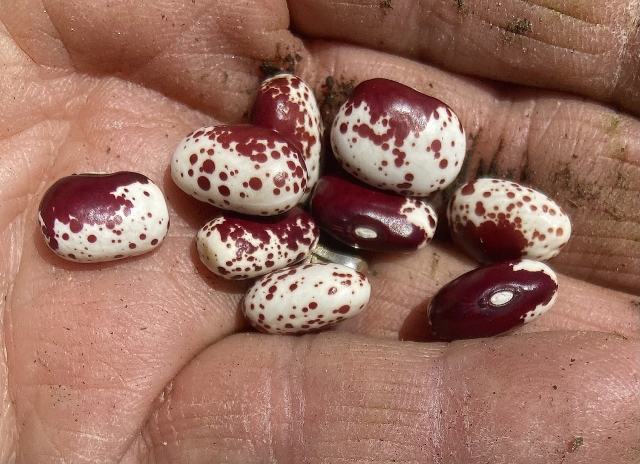
Rouge de Paris dry bush bean from William Woys Weaver
The past 2 years, I’ve been growing out some rare veggie seed varieties from William Woys Weaver (I call him W3), who has collected many rare seeds over the years. Last year for him I grew rare cowpeas but this year I chose beans. This is in addition to my regular tomatoes, zukes, winter squash, cauliflower, chard, beets radishes, cukes and peppers and different varieties of berries/grapes .Good thing I have a BIG garden!
W3 wants his growers to grow out seeds that are getting older to keep the varieties viable. He sent some seeds, you can’t even find online. So this year I’m growing Landreth’s bush bean, Six Nations bush bean, Early Mohawk bush bean, Rouge de Paris bush bean, Wild Pigeon semi-pole bean. All of theses are dry beans. I am also growing one cowpea, Big Red Zipper, a pole cowpea (think black eye peas as we call them in the US) which has long pods with 8-10 large red cow peas that are so beautiful.
The only seeds that did not germinate well was the Landreth’s bean, where only 6 plants germinated out of 30. The seed I received for Landreth’s bean was 6 years old, so it is getting up there in age so I won’t get a lot but he will get whatever I get in the end. This is a good lesson to start saving your seeds! I am also allowed to keep some of each variety as well if I want.
In addition, I am growing out my friend, Lava Ewersmeyer’s, Garrofon Pintat pole butter bean which hails from Spain and Buschbonne Cannolino Rosso bush bean from Germany-both are beautiful white with red splashes. Lava lives in Berlin and here in Santa Fe, enjoying duel citizenship. Lava also gave me seeds for the Lava Red pepper ( a Corno de Horno variety) and Ruthje cherry tomato, both are outstanding which I grow each year as well. Thanks Lava!
Growing new varieties of seeds I’ve never tried before keeps me interested in gardening and I am saving seed that might otherwise go extinct which is important. Hopefully some will be fantastic! I really like bean seeds as so many of them are really beautiful.
Oh and I am growing one green bean for fresh-eating-Emerite pole bean which is a gourmet french filet bean that you can get in the US. I just have to keep up on picking them as if you let them get bigger than a pencil width, the skins get woody. So I pick often when they are ready (which they are not yet).


































